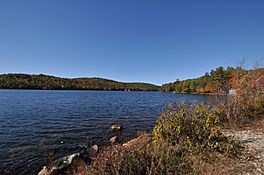Horn Pond facts for kids
Quick facts for kids Horn Pond |
|
|---|---|

View looking west from New Bridge Road in Acton, Maine
|
|
| Location | York County, Maine; Carroll County, New Hampshire |
| Coordinates | 43°33′43″N 70°57′30″W / 43.56194°N 70.95833°W |
| Type | Oligotrophic |
| Primary inflows | Great East Lake Wilson Lake |
| Primary outflows | Salmon Falls River |
| Catchment area | 1,139 acres (1.780 sq mi) |
| Basin countries | United States |
| Max. length | 1.2 mi (1.9 km) |
| Max. width | 0.4 mi (0.64 km) |
| Surface area | 227 acres (0.92 km2) |
| Average depth | 13 ft (4.0 m) Average transparency: 6.6 m (22 ft) |
| Max. depth | 30 ft (9.1 m) |
| Water volume | 3,155,000 m3 (111,417,773.5 cu ft) |
| Residence time | 0.1 years |
| Shore length1 | 4.8 mi (7.7 km) |
| Surface elevation | 551 ft (168 m) |
| Settlements | Acton, ME Wakefield, NH |
| 1 Shore length is not a well-defined measure. | |
Horn Pond is a beautiful lake located right on the border of two US states: Maine and New Hampshire. It's about 227 acres big, which is like 170 football fields! This lake gets its water from underground springs. It also gets water from two other nearby lakes, Great East Lake and Wilson Lake.
Water flows out of Horn Pond into the Salmon Falls River. This river forms a natural border between Maine and New Hampshire. Eventually, the Salmon Falls River empties into the Piscataqua River, which then flows into the Gulf of Maine and the Atlantic Ocean.
About Horn Pond
Horn Pond is a lovely body of water. It sits right on the edge of Acton, Maine, and Wakefield, New Hampshire. The lake is fed by springs and water flowing from Great East Lake and Wilson Lake. Its water then flows into the Salmon Falls River.
The Land Around the Lake
The land around Horn Pond is called its watershed. This area covers about 1,139 acres. Most of this land (70%) is covered by forests. Only a small part (6%) has buildings on it.
Many houses and camps are built along the lake's edge. About half of the shoreline has these buildings. A good portion (44%) of the shoreline is still undeveloped.
Keeping the Water Clean
People have been checking the water quality of Horn Pond since 1982. They collect data to make sure the lake stays healthy. They measure things like how clear the water is, how much phosphorus is in it, and how much oxygen is dissolved in the water.
- Water Clarity: Scientists use a special tool called a secchi disk to measure how clear the water is. This helps them see how far light can go into the lake.
- Phosphorus: They also check for phosphorus. Too much phosphorus can make algae grow too much.
- Dissolved Oxygen: They measure dissolved oxygen. Fish and other lake creatures need oxygen to breathe.
The Horn Pond Association is a group of people who care about the lake. They work to protect and improve the water quality of Horn Pond. They want to make sure the lake stays clean for everyone to enjoy.
What Lives in Horn Pond?
Horn Pond is a great place for fishing! It has both warm-water and cold-water fish. This means many different kinds of fish can live there.
Here are some of the fish you might find in Horn Pond:




